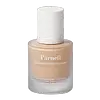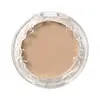What's inside
What's inside
 Key Ingredients
Key Ingredients

 Benefits
Benefits

 Concerns
Concerns

 Ingredients Side-by-side
Ingredients Side-by-side

Water
Skin ConditioningDimethicone
EmollientButylene Glycol
HumectantZinc Oxide
Cosmetic ColorantMethyl Trimethicone
Skin ConditioningButyloctyl Salicylate
Skin ConditioningCI 77891
Cosmetic ColorantEthylhexyl Palmitate
EmollientPhenyl Trimethicone
Skin ConditioningEthylhexyl Stearate
EmollientTitanium Dioxide
Cosmetic ColorantLauryl PEG-9 Polydimethylsiloxyethyl Dimethicone
Skin ConditioningLauryl PEG-10 Tris(Trimethylsiloxy)Silylethyl Dimethicone
EmulsifyingOctyldodecanol
EmollientMagnesium Sulfate
Disteardimonium Hectorite
StabilisingIsododecane
EmollientPolyphenylsilsesquioxane
1,2-Hexanediol
Skin ConditioningPolyisobutene
CI 77492
Cosmetic ColorantTrimethylsiloxysilicate
EmollientSorbitan Sesquioleate
EmulsifyingTribehenin
EmollientCaprylic/Capric Triglyceride
MaskingSynthetic Fluorphlogopite
Centella Asiatica Extract
CleansingAcrylates/Polytrimethylsiloxymethacrylate Copolymer
Skin ConditioningTriethoxycaprylylsilane
Silica
AbrasiveCaprylyl Glycol
EmollientDimethicone/Vinyl Dimethicone Crosspolymer
Skin ConditioningCI 77491
Cosmetic ColorantAluminum Hydroxide
EmollientCI 77499
Cosmetic ColorantPropylene Carbonate
SolventRosmarinus Officinalis Leaf Oil
MaskingSimmondsia Chinensis Seed Oil
EmollientBetaine
HumectantPanthenol
Skin ConditioningGlycerin
HumectantHydroxypropyl Bispalmitamide Mea
EmollientLeptospermum Scoparium Leaf Extract
Skin ConditioningMacadamia Ternifolia Seed Oil
EmollientMadecassoside
AntioxidantTocopherol
AntioxidantHoney Extract
HumectantAngelica Archangelica Root Extract
MaskingCeramide NP
Skin ConditioningFructooligosaccharides
HumectantPullulan
Phytosphingosine
Skin ConditioningViola Tricolor Extract
EmollientHydrogenated Lecithin
EmulsifyingBeta-Glucan
Skin ConditioningLactobacillus Ferment
Skin ConditioningVigna Angularis Seed Extract
Skin ProtectingMaltodextrin
AbsorbentMica
Cosmetic ColorantDistearyldimonium Chloride
Polyglutamic Acid
Skin ConditioningWater, Dimethicone, Butylene Glycol, Zinc Oxide, Methyl Trimethicone, Butyloctyl Salicylate, CI 77891, Ethylhexyl Palmitate, Phenyl Trimethicone, Ethylhexyl Stearate, Titanium Dioxide, Lauryl PEG-9 Polydimethylsiloxyethyl Dimethicone, Lauryl PEG-10 Tris(Trimethylsiloxy)Silylethyl Dimethicone, Octyldodecanol, Magnesium Sulfate, Disteardimonium Hectorite, Isododecane, Polyphenylsilsesquioxane, 1,2-Hexanediol, Polyisobutene, CI 77492, Trimethylsiloxysilicate, Sorbitan Sesquioleate, Tribehenin, Caprylic/Capric Triglyceride, Synthetic Fluorphlogopite, Centella Asiatica Extract, Acrylates/Polytrimethylsiloxymethacrylate Copolymer, Triethoxycaprylylsilane, Silica, Caprylyl Glycol, Dimethicone/Vinyl Dimethicone Crosspolymer, CI 77491, Aluminum Hydroxide, CI 77499, Propylene Carbonate, Rosmarinus Officinalis Leaf Oil, Simmondsia Chinensis Seed Oil, Betaine, Panthenol, Glycerin, Hydroxypropyl Bispalmitamide Mea, Leptospermum Scoparium Leaf Extract, Macadamia Ternifolia Seed Oil, Madecassoside, Tocopherol, Honey Extract, Angelica Archangelica Root Extract, Ceramide NP, Fructooligosaccharides, Pullulan, Phytosphingosine, Viola Tricolor Extract, Hydrogenated Lecithin, Beta-Glucan, Lactobacillus Ferment, Vigna Angularis Seed Extract, Maltodextrin, Mica, Distearyldimonium Chloride, Polyglutamic Acid
Triethylhexanoin
MaskingOctyldodecanol
EmollientSilica
AbrasiveDimethicone
EmollientDibutyl Lauroyl Glutamide
Skin ConditioningOctyldodecyl Neopentanoate
EmollientDisteardimonium Hectorite
StabilisingIsostearyl Alcohol
EmollientOleyl Alcohol
EmollientPolymethyl Methacrylate
Pyrus Malus Fruit Extract
Skin ConditioningDisodium Stearoyl Glutamate
CleansingMica
Cosmetic ColorantHydrolyzed Sodium Hyaluronate
Skin ConditioningPolysilicone-11
Water
Skin ConditioningButylene Glycol
HumectantCaprylyl Glycol
EmollientPhenoxyethanol
PreservativeAluminum Hydroxide
EmollientCarthamus Tinctorius Seed Oil
MaskingHexylene Glycol
EmulsifyingTocopheryl Acetate
AntioxidantTocopherol
AntioxidantAscorbic Acid
AntioxidantDecyl Glucoside
CleansingGlycerin
HumectantSodium PCA
HumectantSodium Lactate
BufferingArginine
MaskingAspartic Acid
MaskingPCA
HumectantSaccharomyces/Magnesium Ferment
Glycine
BufferingAlanine
MaskingSerine
MaskingValine
MaskingSaccharomyces/Copper Ferment
Skin ConditioningPotassium Sorbate
PreservativeSaccharomyces/Silicon Ferment
Skin ConditioningIsoleucine
Skin ConditioningProline
Skin ConditioningThreonine
Saccharomyces/Zinc Ferment
Skin ConditioningHyaluronic Acid
HumectantSaccharomyces/Iron Ferment
Skin ConditioningSilanetriol
Citric Acid
BufferingSorbic Acid
PreservativeHistidine
HumectantPhenylalanine
MaskingTitanium Dioxide
Cosmetic ColorantIron Oxides
Triethylhexanoin, Octyldodecanol, Silica, Dimethicone, Dibutyl Lauroyl Glutamide, Octyldodecyl Neopentanoate, Disteardimonium Hectorite, Isostearyl Alcohol, Oleyl Alcohol, Polymethyl Methacrylate, Pyrus Malus Fruit Extract, Disodium Stearoyl Glutamate, Mica, Hydrolyzed Sodium Hyaluronate, Polysilicone-11, Water, Butylene Glycol, Caprylyl Glycol, Phenoxyethanol, Aluminum Hydroxide, Carthamus Tinctorius Seed Oil, Hexylene Glycol, Tocopheryl Acetate, Tocopherol, Ascorbic Acid, Decyl Glucoside, Glycerin, Sodium PCA, Sodium Lactate, Arginine, Aspartic Acid, PCA, Saccharomyces/Magnesium Ferment, Glycine, Alanine, Serine, Valine, Saccharomyces/Copper Ferment, Potassium Sorbate, Saccharomyces/Silicon Ferment, Isoleucine, Proline, Threonine, Saccharomyces/Zinc Ferment, Hyaluronic Acid, Saccharomyces/Iron Ferment, Silanetriol, Citric Acid, Sorbic Acid, Histidine, Phenylalanine, Titanium Dioxide, Iron Oxides
Ingredients Explained
These ingredients are found in both products.
Ingredients higher up in an ingredient list are typically present in a larger amount.
Aluminum Hydroxide is a form of aluminum. It can be naturally found in nature as the mineral gibbsite. In cosmetics, Aluminum Hydroxide is used as a colorant, pH adjuster, and absorbent.
As a colorant, Aluminum Hydroxide may add opacity, or reduce the transparency. Aluminum hydroxide is contains both basic and acidic properties.
According to manufacturers, this ingredient is an emollient and humectant. This means it helps hydrate the skin.
In medicine, this ingredient is used to help relieve heartburn and help heal ulcers.
There is currently no credible scientific evidence linking aluminum hydroxide in cosmetics to increased cancer risk.
Major health organizations allow the use of aluminum hydroxide in personal care products and have not flagged it as a carcinogenic risk at typical usage levels.
Learn more about Aluminum HydroxideButylene Glycol (or BG) is used within cosmetic products for a few different reasons:
Overall, Butylene Glycol is a safe and well-rounded ingredient that works well with other ingredients.
Though this ingredient works well with most skin types, some people with sensitive skin may experience a reaction such as allergic rashes, closed comedones, or itchiness.
Learn more about Butylene GlycolCaprylyl Glycol is a humectant and emollient, meaning it attracts and preserves moisture.
It is a common ingredient in many products, especially those designed to hydrate skin. The primary benefits are retaining moisture, skin softening, and promoting a healthy skin barrier.
Though Caprylyl Glycol is an alcohol derived from fatty acids, it is not the kind that can dry out skin.
This ingredient is also used as a preservative to extend the life of products. It has slight antimicrobial properties.
Learn more about Caprylyl GlycolDimethicone is a type of synthetic silicone created from natural materials such as quartz.
What it does:
Dimethicone comes in different viscosities:
Depending on the viscosity, dimethicone has different properties.
Ingredients lists don't always show which type is used, so we recommend reaching out to the brand if you have questions about the viscosity.
This ingredient is unlikely to cause irritation because it does not get absorbed into skin. However, people with silicone allergies should be careful about using this ingredient.
Note: Dimethicone may contribute to pilling. This is because it is not oil or water soluble, so pilling may occur when layered with products. When mixed with heavy oils in a formula, the outcome is also quite greasy.
Learn more about DimethiconeDisteardimonium Hectorite comes from the clay mineral named hectorite. It is used to add thickness to a product.
It can also help stabilize a product by helping to disperse other ingredients.
Hectorite is a rare, white clay mineral.
Learn more about Disteardimonium HectoriteGlycerin is already naturally found in your skin. It helps moisturize and protect your skin.
A study from 2016 found glycerin to be more effective as a humectant than AHAs and hyaluronic acid.
As a humectant, it helps the skin stay hydrated by pulling moisture to your skin. The low molecular weight of glycerin allows it to pull moisture into the deeper layers of your skin.
Hydrated skin improves your skin barrier; Your skin barrier helps protect against irritants and bacteria.
Glycerin has also been found to have antimicrobial and antiviral properties. Due to these properties, glycerin is often used in wound and burn treatments.
In cosmetics, glycerin is usually derived from plants such as soybean or palm. However, it can also be sourced from animals, such as tallow or animal fat.
This ingredient is organic, colorless, odorless, and non-toxic.
Glycerin is the name for this ingredient in American English. British English uses Glycerol/Glycerine.
Learn more about GlycerinMica is a naturally occurring mineral used to add shimmer and color in cosmetics. It can also help improve the texture of a product or give it an opaque, white/silver color.
Serecite is the name for very fine but ragged grains of mica.
This ingredient is often coated with metal oxides like titanium dioxide. Trace amounts of heavy metals may be found in mica, but these metals are not harmful in our personal products.
Mica has been used since prehistoric times throughout the world. Ancient Egyptian, Indian, Greek, Roman, Aztec, and Chinese civilizations have used mica.
Learn more about MicaOctyldodecanol is a fatty alcohol. It is primarily used to enhance the texture of products.
As an emulsifier, Octyldodecanol helps prevent the oils and waters from separating. It also prevents ingredients from creating foam when shaken.
Octyldodecanol is created by reducing fatty acid to an alcohol.
Due to its high molecular weight, it does not get absorbed into the skin.
Learn more about OctyldodecanolSilica, also known as silicon dioxide, is a naturally occurring mineral. It is used as a fine, spherical, and porous powder in cosmetics.
Though it has exfoliant properties, the function of silica varies depending on the product.
The unique structure of silica enhances the spreadability and adds smoothness, making it a great texture enhancer.
It is also used as an active carrier, emulsifier, and mattifier due to its ability to absorb excess oil.
In some products, tiny microneedles called spicules are made from silica or hydrolyzed sponge. When you rub them in, they lightly polish away dead skin layers and enhance the penetration of active ingredients.
Learn more about SilicaTitanium dioxide is a mineral UV filter widely used in sunscreens and cosmetics.
It is one of only two UV filters officially classified as “mineral” by regulatory agencies, the other being zinc oxide.
Titanium dioxide provides broad-spectrum protection mostly in the UVB and UVAII range, with some protection in the UVAI range.
While its UVA protection isn’t as strong as zinc oxide’s, the difference is minor.
A common myth is that mineral UV filters reflect UV light. However, modern research shows titanium dioxide absorbs UV radiation like chemical filters (~95% absorption & 5% reflection).
Thanks to its non-irritating nature, titanium dioxide is suitable for sensitive, acne-prone, or redness-prone skin. It is unlikely to cause "eye sting" like other sunscreen ingredients.
A major drawback of this ingredient is its white cast and thick texture. This is why mineral sunscreens often leave a white cast and are less cosmetically elegant than chemical/hybrid sunscreens.
To improve white cast and spreadability, micronized or nano-sized titanium dioxide is often used.
There are ongoing concerns surrounding nano-titanium oxide's impact on marine ecosystems.
There is no conclusive evidence that any form of titanium oxide (or any other sunscreen ingredients) will cause harm to marine ecosystems or coral reefs. The science is still developing but many consumers are keeping a close eye on this issue.
Please note, many destinations have reef-safety sunscreen rules. For instance, the U.S. Virgin Islands advises all visitors to use non-nano mineral sunscreens.
Nano mineral sunscreens once raised safety concerns about absorption into skin.
Extensive research has shown that they do not penetrate healthy or damaged skin; they remain safely on the surface and the top layer of dead skin (stratum corneum).
You'll likely find titanium dioxide bundled with alumina, silica, or dimethicone. These ingredients help make titanium dioxide highly photostable; this prevents it from interacting with other formula components under UV light.
Learn more about Titanium DioxideTocopherol (also known as Vitamin E) is a common antioxidant used to help protect the skin from free-radicals and strengthen the skin barrier. It's also fat soluble - this means our skin is great at absorbing it.
Vitamin E also helps keep your natural skin lipids healthy. Your lipid skin barrier naturally consists of lipids, ceramides, and fatty acids. Vitamin E offers extra protection for your skin’s lipid barrier, keeping your skin healthy and nourished.
Another benefit is a bit of UV protection. Vitamin E helps reduce the damage caused by UVB rays. (It should not replace your sunscreen). Combining it with Vitamin C can decrease sunburned cells and hyperpigmentation after UV exposure.
You might have noticed Vitamin E + C often paired together. This is because it is great at stabilizing Vitamin C. Using the two together helps increase the effectiveness of both ingredients.
There are often claims that Vitamin E can reduce/prevent scarring, but these claims haven't been confirmed by scientific research.
Learn more about TocopherolWater. It's the most common cosmetic ingredient of all. You'll usually see it at the top of ingredient lists, meaning that it makes up the largest part of the product.
So why is it so popular? Water most often acts as a solvent - this means that it helps dissolve other ingredients into the formulation.
You'll also recognize water as that liquid we all need to stay alive. If you see this, drink a glass of water. Stay hydrated!
Learn more about Water